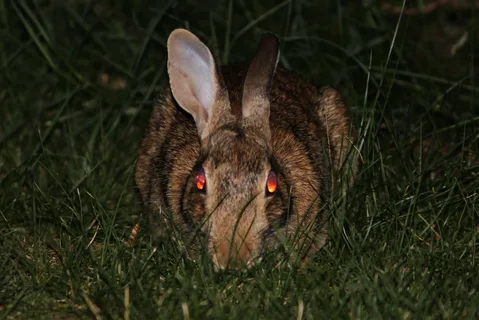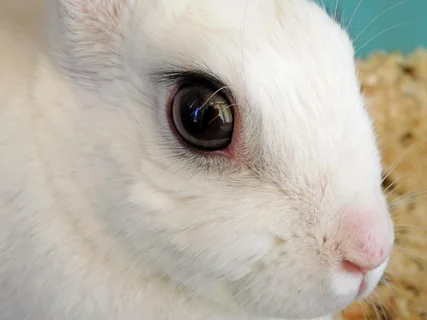The night is full of mystery and intrigue. As the sun sets and darkness blankets the sky, most assume that all activities cease until dawn. However, some animals are just becoming active as night falls. Rabbits are one such creature that folks frequently misunderstand in regards to their vision and nocturnal behaviors.
This comprehensive deep dive seeks to shed light on a rabbit’s true abilities in low light conditions through in depth research and discoveries. Can rabbits see in the dark? Let’s explore.
How can Rabbits see in the dark:
Understanding how can rabbits see in the dark requires examining their unique structural developments postnatally and into adulthood. Rabbits are precocial, meaning they can see and function shortly after birth. However, much like humans, their ocular system continues refining well past infancy. This allows advantageous traits to emerge as they mature.
The large spherical eyes of an adult rabbit are located on each side of its head for wide panoramic vision. Their pupils can expand to an astonishing 10 millimeters in diameter, maximizing the merest hint of incoming photons. Behind each retina lies an extra reflective layer called the tapetum lucidum. This gives incoming light a second pass at stimulating the photoreceptor cells.
Rabbit eyes contain both rod and cone cells. By packing more opsin molecules into each disc, the rods are optimized for scotopic, or low ight, vision. They are 100 times more sensitive than cones. Rod dominance helps rabbits see in dim conditions, although this comes at the expense of color perception.
Studies show that rod cells outnumber cones by about 20:1 in rabbits compared to only 50:1 in humans. And this is the reason rabbits can see in the dark.
Combined, these ocular adaptations result in a nocturnal visual acuity leagues beyond our own. One study used electroretinography to measure retinal light sensitivity thresholds across species.
It ranked rabbits able to sense photons at intensities 6 to 10 times lower than humans could discern akin to detecting a single candle across a football field on a moonless night. Their eyes literally take in over half a log unit more light than we do in darkness.
Diving Deeper into a Rabbit’s Specialized Night Vision
While no match for true night hunters like owls, rabbits outstrip most other prey animals when the sun sets. Let’s explore comparative low light visual abilities:
Rabbits vs. Cats: A rabbit’s retinal light sensitivity comes close to a cat’s, which also boasts tapetum and enlarged pupils. Both vastly exceed human thresholds, suggesting rabbits perceive night as clearly as cats.
Rabbits vs. Dogs: In low light, dogs transition from color to greyscale night vision as rods dominate. They rely more on other enhanced senses rather than vision alone after dark. Rabbits maintain full color discernment down to much dimmer conditions.
Rabbits vs. Owls: Nocturnal raptors like owls boast 10,000 to100,000 more rod cells per retinal area than rabbits. Their retinas also concentrate more melanin for amplifying rod signals. This gives owls astonishing low-light acuity, up to 100 times better than a human’s. While not at this level, rabbits still see 6-10x better than us.
Rabbits vs. Deer: As fellow herd grazers, deer have weaker night vision than rabbits. Their pupils constrict rather than dilate fully in darkness. Rod counts remain similar to diurnal creatures rather than increasing for low light tasking like rabbits. Thus rabbits possess a distinct survival edge when predator risks skyrocket after nightfall.
Additional Nocturnal Senses and Behaviors Give Rabbits an Edge
Rabbits depend on more than just vision to navigate successfully at night. Here are some key multisensory adaptations:
Acute Hearing: Rabbits have especially large ears that can rotate 180 degrees independently. Their auditory system tunes into low frequency sounds up to 30kHz, allowing them to detect threats from great distances, even out of sight.
Tactile Whiskers: These highly sensitive whiskers number up to 100 per side and aid spatial awareness, motion detection and object localization when visual details fade. Rabbits use them for everything from navigating warrens to warning of air currents indicating predator approach.
Enhanced Olfaction: Their powerful sense of smell supports tasks like identifying mates, territories and food sources even in limited light. The vomeronasal organ at the roof of the mouth detects pheromones for social interactions.
Nocturnal Feeding: Wild rabbits time peak foraging and grazing for night time hours, taking advantage of reduced diurnal predation risks to maximize energy intake before dawn.
Social Behaviors: Nursing, grooming, playing and courtship also shift later into darkness under the cover of night for added concealment from threats like hawks and foxes.
Common Night Vision Myths Laid to Rest
Despite their genuine nighttime capabilities, some mistaken impressions endure that contradict what science tells us:
Myth: Rabbits freeze with fear in the dark.
Fact: Rabbits evolved to feel secure with their innate night vision intact. Fear reactions arise from human projections, not rabbit physiology or behavior.
Myth: Rabbits sleep all night and do nothing.
Fact: Nocturnal activity patterns are part of their natural lifestyle, whether in the wild or as pets. Even indoor housed rabbits display nightly active periods.
Myth: Rabbits can’t see anything at all after sunset.
Fact: While less acute than daytime color vision, a rabbit’s perceptual faculties remain sharp enough for survival tasks like detecting movement or danger signs in limited lighting. They see far better than we tend to realize.
Myth: Rabbits are blind as bats at night.
Fact: Bats actually have exceptional low light and even infrared senses far surpassing a human or rabbit’s capabilities thanks to echolocation. Rabbit vision accomplishes its evolutionary aims through optical adaptations rather than sounds.
The common theme uniting these false beliefs seems to derive from projection of human nocturnal frailties onto another species. But rabbits evolved precise mechanisms allowing true functionality when most other prey animals remain nearly sightless.
FAQs
Q: Can Rabbits See in the Dark?
A: Rabbits cannot see in complete darkness, however they do have better vision than humans in low levels of light.
Q: Do rabbits need light at night?
A: Light is important for the crepuscular or nocturnal animal species such as wild or domesticated rabbits
Q: Is rabbits afraid of the dark?
A: they can be frightened by loud noises and sudden movements, but that happens even in the light.
Q: Do rabbits recognize their owner?
A: can usually recognize their owners by sight and sound.
Q: Do rabbits like dark rooms?
A: A darkened sheltered area for sleeping away from noise and another for eating/relaxing.
CONCLUSION ABOUT HOW CAN RABBITS SEE IN THE DARK:
Rabbits rank among the most successful herbivores on Earth, persisting across habitats from continent to continent for millions of years. A major reason lies in their specialized adaptability once darkness falls. While humans question whether rabbits see in the dark?, science now proves their visual acuity remains keen, rivaling many hunters twice their size.
Additional honed senses and instinctive nighttime behaviors give these petite lagomorphs distinct advantages over potential threats lurking after sunset.
The next time you observe your rabbit nimbly navigating its enclosure under moon or starlight, appreciate it not as visual impairment but illumination a testament to evolutionary victors where predators assume their prey sightless after dark.
For rabbits dwelling on every continent except Antarctica, night truly is no impediment thanks to millennia of specialization for low light survival. Rabbits, quite simply, can see clearly and capably in the dark.










